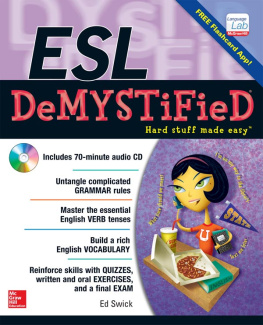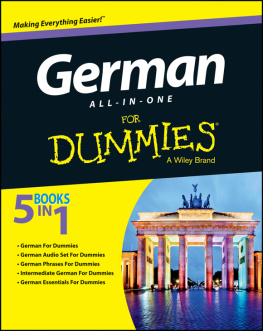Contents
Guide
Page List


Copyright 2019 by McGraw-Hill Education. All rights reserved. Except as permitted under the United States Copyright Act of 1976, no part of this publication may be reproduced or distributed in any form or by any means, or stored in a database or retrieval system, without the prior written permission of the publisher.
ISBN: 978-1-26-014378-2
MHID: 1-26-014378-3
The material in this eBook also appears in the print version of this title: ISBN: 978-1-26-014377-5, MHID: 1-26-014377-5.
eBook conversion by codeMantra
Version 1.0
All trademarks are trademarks of their respective owners. Rather than put a trademark symbol after every occurrence of a trademarked name, we use names in an editorial fashion only, and to the benefit of the trademark owner, with no intention of infringement of the trademark. Where such designations appear in this book, they have been printed with initial caps.
McGraw-Hill Education eBooks are available at special quantity discounts to use as premiums and sales promotions or for use in corporate training programs. To contact a representative, please visit the Contact Us page at www.mhprofessional.com.
Trademarks: McGraw-Hill Education, the McGraw-Hill Education logo, Practice Makes Perfect, and related trade dress are trademarks or registered trademarks of McGraw-Hill Education and/or its affiliates in the United States and other countries and may not be used without written permission. All other trademarks are the property of their respective owners. McGraw-Hill Education is not associated with any product or vendor mentioned in this book.
McGraw-Hill Education Language Lab App
Audio recordings of all Conversations in this book are available as streaming audio via our unique Language Lab app. Go to mhlanguagelab.com to access the online version of this application, or download the mobile version from the Apple App store (for iPhone and iPad), or the Google Play store (for Android devices). Note: Internet connection required.
TERMS OF USE
This is a copyrighted work and McGraw-Hill Education and its licensors reserve all rights in and to the work. Use of this work is subject to these terms. Except as permitted under the Copyright Act of 1976 and the right to store and retrieve one copy of the work, you may not decompile, disassemble, reverse engineer, reproduce, modify, create derivative works based upon, transmit, distribute, disseminate, sell, publish or sublicense the work or any part of it without McGraw-Hill Educations prior consent. You may use the work for your own noncommercial and personal use; any other use of the work is strictly prohibited. Your right to use the work may be terminated if you fail to comply with these terms.
THE WORK IS PROVIDED AS IS. McGRAW-HILL EDUCATION AND ITS LICENSORS MAKE NO GUARANTEES OR WARRANTIES AS TO THE ACCURACY, ADEQUACY OR COMPLETENESS OF OR RESULTS TO BE OBTAINED FROM USING THE WORK, INCLUDING ANY INFORMATION THAT CAN BE ACCESSED THROUGH THE WORK VIA HYPERLINK OR OTHERWISE, AND EXPRESSLY DISCLAIM ANY WARRANTY, EXPRESS OR IMPLIED, INCLUDING BUT NOT LIMITED TO IMPLIED WARRANTIES OF MERCHANTABILITY OR FITNESS FOR A PARTICULAR PURPOSE. McGraw-Hill Education and its licensors do not warrant or guarantee that the functions contained in the work will meet your requirements or that its operation will be uninterrupted or error free. Neither McGraw-Hill Education nor its licensors shall be liable to you or anyone else for any inaccuracy, error or omission, regardless of cause, in the work or for any damages resulting therefrom. McGraw-Hill Education has no responsibility for the content of any information accessed through the work. Under no circumstances shall McGraw-Hill Education and/or its licensors be liable for any indirect, incidental, special, punitive, consequential or similar damages that result from the use of or inability to use the work, even if any of them has been advised of the possibility of such damages. This limitation of liability shall apply to any claim or cause whatsoever whether such claim or cause arises in contract, tort or otherwise.
Contents
Acknowledgment
Many thanks to Stefan Feyen for his advice and keen eye for detail.
Introduction
In the Practice Makes Perfect series of German books, the books are designed around a specific grammatical or structural topic. This book, however, is designed to provide linguistic scenarios that reinforce conversational language. Grammar and vocabulary are of course used in all foreign-language books and therefore appear in this book as well. However, the main goal here is to develop conversational skills in German, not just to practice grammatical structures and vocabulary.
How to use this book
Each chapter begins with a dialogue on a topic that is the basis for the content of the chapter. The dialogues are relatively short and are written in natural language appropriate for intermediate readers. Following each dialogue is a series of questions that check for a basic understanding of the dialogue and competence with new, important conversational structures.
New to this premium second edition, recordings of all of the dialogs in the book are available as streaming audio through the McGraw-Hill Education Language Lab app. In addition, the answers of many of the exercises in this book have also been recorded.
Although lists of words and phrases are provided, they are not composed of random words and phrases but rather of terms that are linked to the topic of the chapter. Then the words and phrases are introduced again, but this time in complete sentences appropriate for a conversation on the topic of the chapter.
Numerous exercises are provided to give detailed practice with the new words and phrases. Some of the exercises repeat an important grammatical concept and simultaneously use that concept as a vehicle for manipulation of the new conversational material. Other exercises check for comprehension or the ability to use new words in a useful phrase.
The reader should not forget that this book practices conversational German. Therefore, it is important that every German word and phrase be pronounced out loud. Conversations, in any language, are not merely silent thoughts in ones head. They are spoken entities. When working with the introductory dialogues, say each line out loud, and you cannot say them smoothly, practice them until you can say them with ease. And, of course, always think about the meaning of each line. Readers have to know what they are talking about.
Read all the lists of words, phrases, and sentences out loud as well and, again, practice them until you can say them smoothly. Do the same for the exercises. Write down the answers to the exercises, but dont stop there. Read the exercise aloud and then practice reading your answers aloud until you can say them easily and naturally.
At the end of the book there is an Answer key. Be sure to check your answers againt the Answer key before practicing saying them out loud.
German alphabet and pronunciation
German, like English and many other European languages, is written using the Latin alphabet. Use the following descriptions of German letters and their pronunciations to guide you through this book. When in doubt about how to pronounce a word, ask a German-speaking friend or consult a dictionary.














